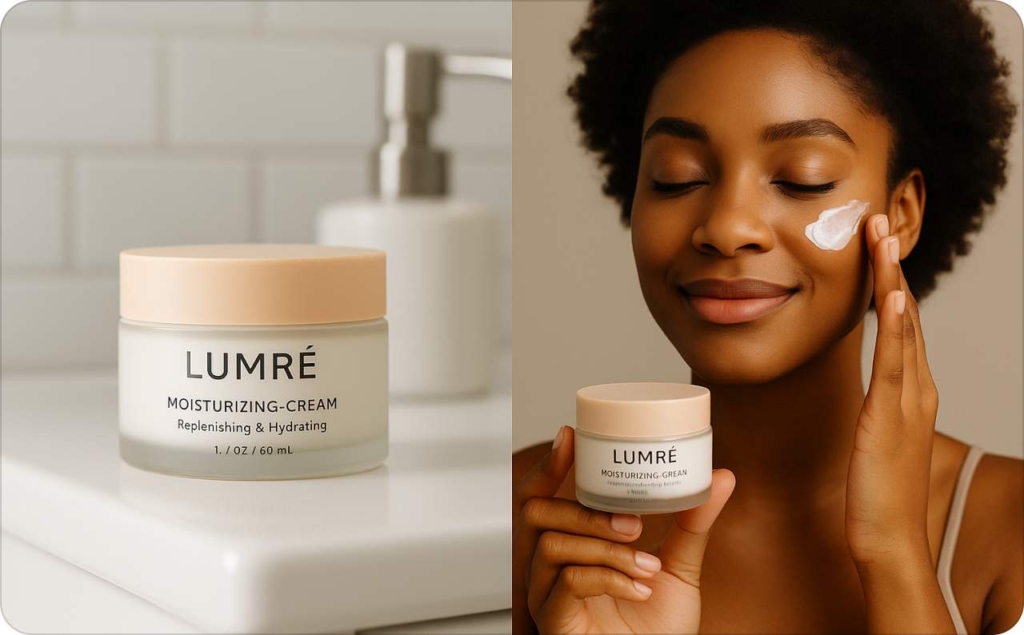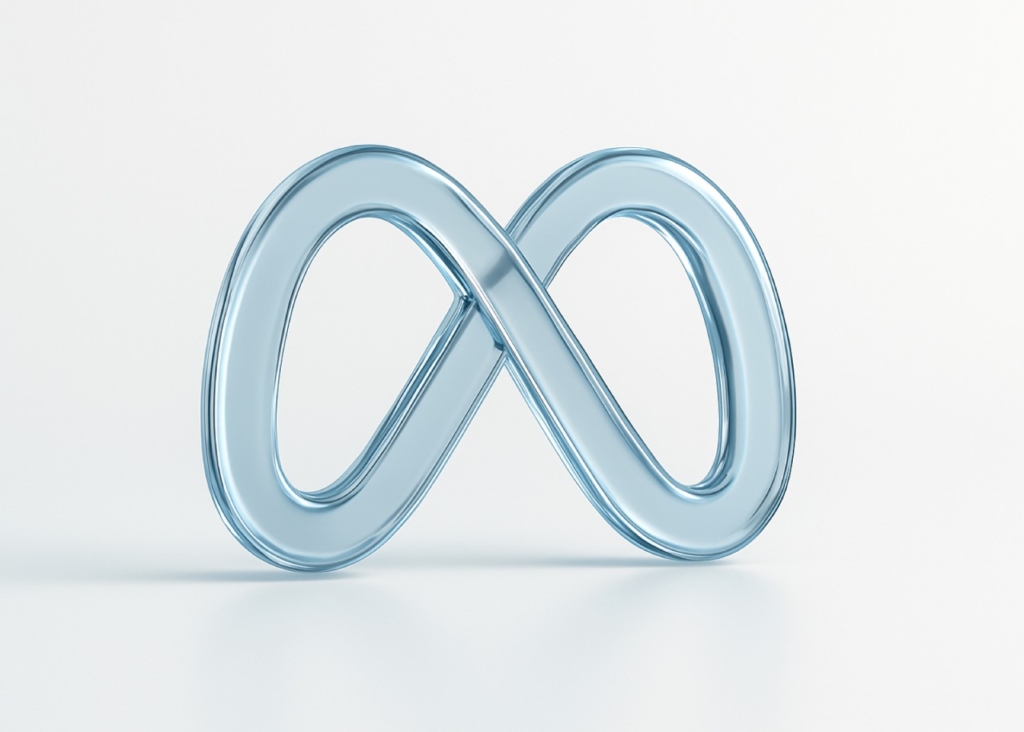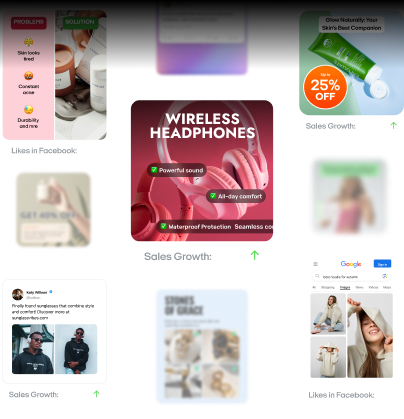Interstitial ad examples for 2025: Android AdMob and website playbooks with UX-safe ideas
Wondering how to design interstitial ads that engage without annoying users? Zeely AI showcases 2025’s best interstitial ad examples with UX-safe, high-performing strategies.
- Picture a pause. You finish a level in a mobile game or reach the end of an article
- An interstitial ad appears. It takes the full screen and offers a clear call to action
- You decide. You tap through or close it, and the experience continues
Interstitial ads can deliver 5–10× higher CTR than banners. But if you place them at the wrong time, they may hurt your rankings. Google explains these risks in its Page Experience guidelines. In this article, you’ll see the best interstitial ads example for Android and web, plus how to use frequency capping and pre-cache ads for seamless integration.

What is an interstitial ad
An interstitial ad is when you show a full-screen overlay ad between actions, not on top of content. It appears at natural transition points such as level win, post-checkout, or after reading. It is different from a popup or banner because it takes the whole viewport, then closes cleanly.
You need to follow interstitial ad format best practices, pre-cache ads, and cap frequency to prevent user experience disruption and SEO issues.
Types and formats of interstitial ads
Digital advertising is expected to account for 73% of global ad spend in 2025, up significantly from previous years. GroupM projects $1.1 trillion in total ad spend, with digital dominating. This trend supports using richer interstitial formats, as long as you keep UX safe.
You have four core formats that map to interstitial ad examples on Android apps or websites.
Static
What it is: A simple, full-screen image interstitial — quick to design and faster to load than video or rich media.
When to use it: Perfect for news sites, blogs, or productivity apps where speed matters most.
Why it works: Static interstitials are light, load instantly, and are simple to pre-cache ads. They slot in smoothly at natural transition points like the end of an article or after a completed task.
What you can expect:
- CTR that’s typically 20–30% higher than banners
- A stable baseline for running a CTR vs eCPM comparison
Watch out: Don’t trigger on page load, and always show a clear close button to avoid the Google mobile interstitial penalty.
Video
What is: A full-screen video ad that adds motion, sound, and storytelling.
When to use it: Great for brand recall, app installs, or storytelling. Popular in gaming apps, entertainment platforms, and ecommerce onboarding.
Why it works: Video interstitials bring visuals, motion, and sound that engage users. Just make sure you pre-cache ads so playback is smooth.
What you can expect:
- More engagement and higher installs compared to static
- Often 2–3× eCPM uplift
Watch out: Avoid autoplay with sound and don’t use long, unskippable 30-second clips — they frustrate users and hurt retention.
Rich Media / Interactive
What are rich media ads: An interactive format with animations, swipe actions, or mini-quizzes.
When to use it: Best for product demos, quizzes, or retail previews where you want users to interact.
Why it works: Rich media ads mix visuals, animations, and gestures like swipe or tap. Done well, they create seamless ad integration without breaking flow.
What you can expect:
- Around 25% higher CTR than static ads
- Stronger brand recall through interaction
Watch out: Keep file sizes small. Heavy assets cause slow loads and layout jumps. Always keep controls visible and accessible.
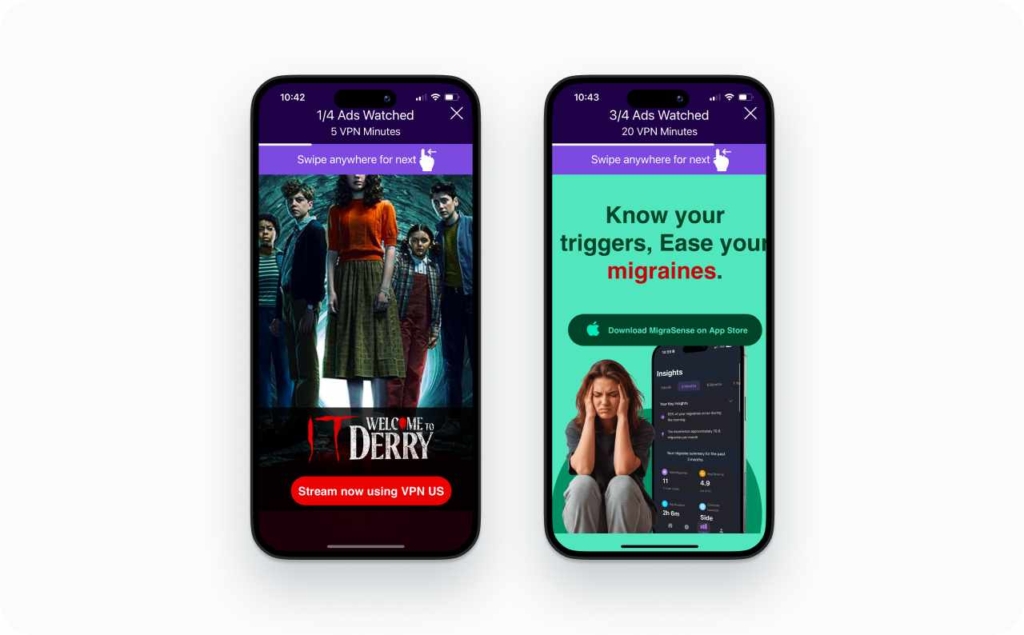
Playable
What it is: A short, interactive demo that lets users try before they install.
When to use it: Perfect for gaming, fitness, or education apps where “try before you install” is a natural fit.
Why it works: Playables let users test a mini-demo. A short, fun trial convinces them of the value before they commit.
What you can expect:
- Often 5–10× CTR compared to banners
- High conversion rates when capped properly with frequency capping
Watch out: Don’t make the demo glitchy or too long. And never block core content behind a playable interstitial.
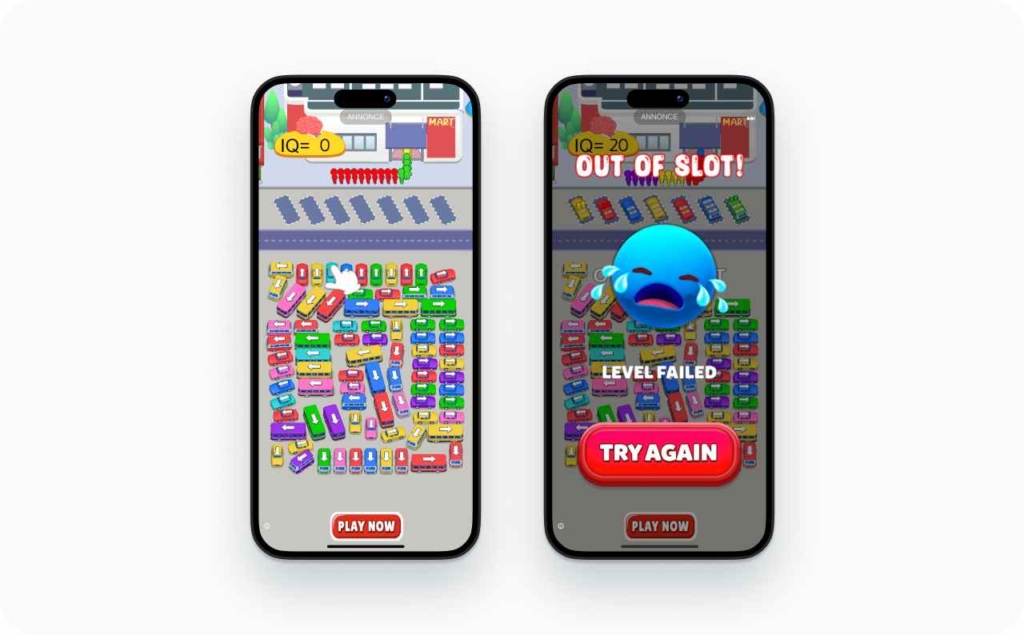
Advantages and disadvantages of interstitial ads
Interstitial ads can boost revenue and engagement, but they come with risks if used poorly. Business owners often ask: “Will this improve my CTR without hurting SEO?” and “What’s the right balance with frequency capping?” The table below gives you a clear view of where interstitials shine and where they can backfire.
| Advantage | Why it helps your business | Disadvantage | Risk if ignored |
| Real examples of interstitial ads that increase CTR | Interstitials often deliver 5–10× higher CTR than banners, especially in apps and games. | How to use interstitial ads without hurting SEO | Placing them on page load or blocking content can trigger the Google mobile interstitial penalty and hurt rankings. |
| Interstitial ads case study Pinterest Airbnb | Big brands use interstitials at natural transition points to drive installs and retention. | Best frequency capping for interstitial ads | Without caps, users feel spammed, uninstall apps, or leave sites quickly. |
| Interstitial ad examples on Android apps or websites | They fit many contexts — e.g., AdMob interstitial ads Android example after level completion or website interstitial ads example after an article. | User experience disruption | Bad timing (e.g., during gameplay or mid-scroll) frustrates users and damages trust. |
| CTR vs eCPM comparison | Interstitials usually outperform banners in both CTR and eCPM, making monetization more efficient. | Seamless ad integration failure | If design feels intrusive or unpolished, users dismiss the ad, lowering conversions. |
| Pre-cache ads for faster load | Pre-caching ensures ads load instantly, improving impressions and user satisfaction. | Heavy assets in rich media or playable | Long load times reduce session duration and may increase churn. |
Use interstitials when they naturally fit the user journey — after a level win, article finish, or checkout. Always apply frequency capping, pre-cache ads for smooth delivery, and run a CTR vs eCPM comparison against banners to measure success. Avoid showing them on page load or blocking core content, or you risk penalties and lost trust.
Top 10 interstitial ads examples
Interstitials work differently depending on where you place them — inside an app using AdMob SDK or on the web as overlays. Below, you’ll see the top 10 interstitial ads examples split into App-based (Android/AdMob) and Web-based (browser) use cases. Each example explains why it works, how to use it, and what to avoid to prevent penalties.
App-based Android / AdMob SDK examples
If you run a mobile app, interstitials can lift monetization and engagement when used at natural transition points. Here are five AdMob interstitial ads Android examples you can test in your own flow.
Level-win screen
Show an interstitial right after a level ends, never during play. This full-screen overlay ad hits natural transition points; you pre-cache ads during the level so display is instant for seamless ad integration.
Why it works
- Player attention peaks post win or loss
- Clean break lowers user experience disruption
- Frequency capping preserves session satisfaction
- Beats banners in a CTR vs eCPM comparison
How to use it
In your AdMob interstitial ads Android example setup, pre-cache ads on level start and show on the results screen. Log impression, click, and dismiss. Cap to one every two minutes. This interstitial ads example Android is easy to A/B test against a banner baseline.
Wrong way that risks penalties
- Showing mid-level or on app launch
- Hiding or delaying the close button
- Triggering on first content paint for Search visitors or stacking back-to-back without frequency capping, which can invite a Google mobile interstitial penalty
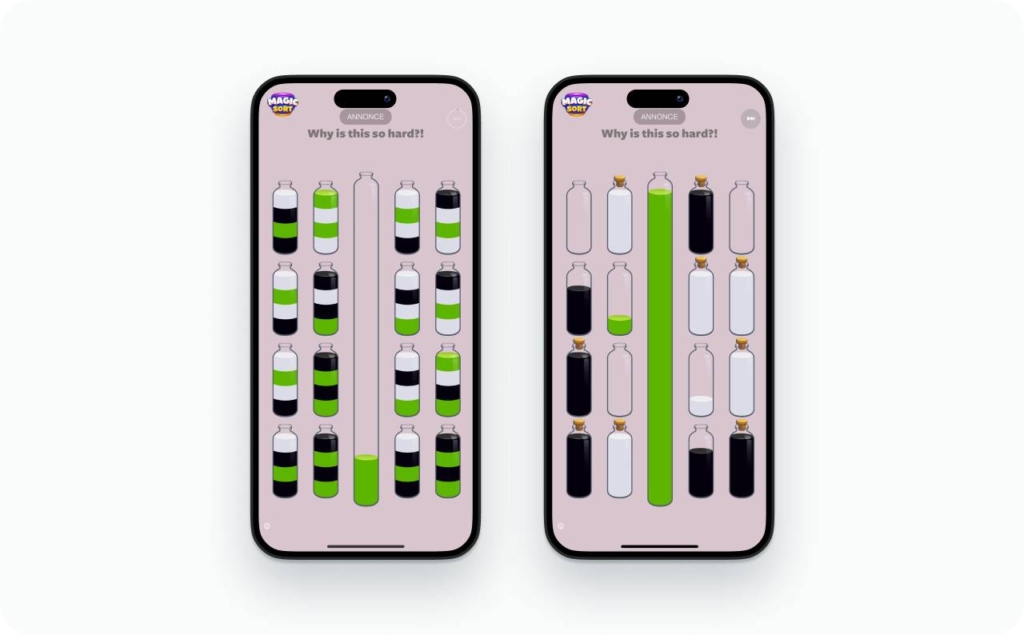
Post-onboarding finish
You show an interstitial only after onboarding ends. The user finishes tasks and is open to a free feature or trial. This is a clean interstitial ads example Android at natural transition points with seamless ad integration.
Why it works
- Motivation peaks at completion
- Low interruption risk and better trust
- Easy frequency capping and pre-cache ads
- Matches AdMob interstitial ads Android example flows
How to use it
Preload on the final onboarding screen, then show on checklist completion. Track impression, click, dismiss, and run a CTR vs eCPM comparison versus banners.
Wrong way that risks penalties
- Showing on first app open or mid-step
- Hiding the close button or delaying it too long
- Triggering before content becomes available, which can invoke the Google mobile interstitial penalty

Feature-to-feature hop
Export to share: reinforce product value
You display after an export completes, not during editing. Attention is free, so your full-screen overlay ad lands without user experience disruption.
Why it works
- Cognitive load is clear after success
- Natural pause supports frequency capping
- Often beats banners in CTR vs eCPM comparison
- Strong seamless ad integration pattern
How to use it
Fire on export success, pre-cache ads during processing, then show after the success toast.
Wrong way that risks penalties
- Interrupting the export process or covering OS share sheets
- Auto-showing after a user taps “Share,” which breaks expected navigation
- Repeating on every export with no best frequency capping for interstitial ads
Long-session promo
You serve one interstitial every 8–12 minutes, but only at pause menus. You keep timing predictable and respect interstitial ads placement timing.
Why it works
- Rhythm reduces fatigue
- Frequency capping protects retention
- Mediation optimizes eCPM
- Safer than mid-action popups
How to use it
Use a session timer and pre-cache ads in the background. Show only at natural transition points and compare to banners in a CTR vs eCPM comparison.
Wrong way that risks penalties
- Firing mid-level or mid-typing
- Showing on app launch or chaining two interstitials back-to-back
- Tiny or obscured close areas that drive accidental clicks
Day-N re-engagement gate
You target returners on Day-7 or Day-14 and show an interstitial after the first completed micro task. This aligns with AdMob interstitial ads Android example best practice.
Why it works
- Renewed intent after a break
- Offers feel timely and personal
- Frequency capping reduces annoyance
- Keeps how interstitial ads affect UX/SEO positive
How to use it
Segment return cohorts, pre-cache ads on the first screen, then show after a small success. Measure lift with a CTR vs eCPM comparison.
Wrong way that risks penalties
- Showing before any action on return
- Gating main content behind an ad
- Re-showing on every screen with no cap, which creates user experience disruption
Website interstitial ads examples
Exit-intent interstitials for newsletter or promo
You trigger exit-intent interstitials when the cursor moves to close or back. This website interstitial ads example minimizes friction and supports how to use interstitial ads without hurting SEO.
Why it works
- Matches leave intent precisely
- Low interruption for readers
- Helps owned list growth
- Easy to cap per day
How to use it
Use a single field, frequency capping per day, a visible close, and seamless ad integration.
Wrong way that risks penalties
- Showing on page load for mobile users from Search
- Stacking multiple overlays before accessing content
- Slow, shifting panels that cause CLS and risk Google mobile interstitial penalty
Paywall or age-gate
You use a compliant overlay for subscriptions or regulated content with a clear purpose. It is an accepted website interstitial ads example when configured correctly.
Why it works
- Explicit need, clear value
- Legal justification supports SEO safety
- Users expect the interruption
- Keeps trust when transparent
How to use it
Whitelist entry paths, provide a crawlable preview, keep CLS stable, pre-cache ads or assets, and ensure accessibility.
Wrong way that risks penalties
- Applying the gate to all organic entries without preview
- Mixing ads into legal dialogs that block main content
- Hiding the close or preventing access to the promised preview

Photo source: Le Monde
Post-article completion to subscription
You show only after the last paragraph, never mid-read. This aligns with natural transition points and keeps seamless ad integration.
Why it works
- Honors attention flow
- Higher readiness to act
- Clear measurement for interstitial ads CTR benchmarks
- Strong interstitial ads vs banner ads uplift
How to use it
Detect real completion with scroll and time signals, pre-cache ads, then cap to once per session.
Wrong way that risks penalties
- Showing before any content is visible
- Reopening after dismissal during the same session
- Heavy overlays that cause CLS spikes and trigger the Google mobile interstitial penalty
Seasonal promo from category to PDP
You present a short interstitial when moving from category to PDP during peak weeks. Use rich media carefully to avoid user experience disruption.
Why it works
- Holiday intent is strong
- Visuals can lift recall
- Clear path maintains flow
- Helps yield during peak eCPM windows
How to use it
Limit to seasonal periods, pre-cache ads on category, and show on click to PDP. Compare results in a CTR vs eCPM comparison.
Wrong way that risks penalties
- Blocking the PDP from organic visitors
- Triggering on page load with no user action
- Causing layout shifts that fail Core Web Vitals

Photo source: Forbes
Lead magnet after docs or resources
You offer a guide download after a tutorial ends. This interstitial ads example connects content to value and keeps how interstitial ads affect UX/SEO in a safe zone.
Why it works
- Tight content match
- Clear separation from main content
- Helps grow owned demand
- Often wins in CTR vs eCPM comparison
How to use it
Track completion, pre-cache ads at 70–80 percent progress, cap daily, then route to a fast landing page.
Wrong way that risks penalties
- Blocking docs for users from Search with a hard wall
- Faking the download button or hiding the close
- Asking for too many fields before any preview
Google’s page-experience guidance and intrusive interstitials documentation remain current and reference non intrusive dialogs as best practice in 2025.
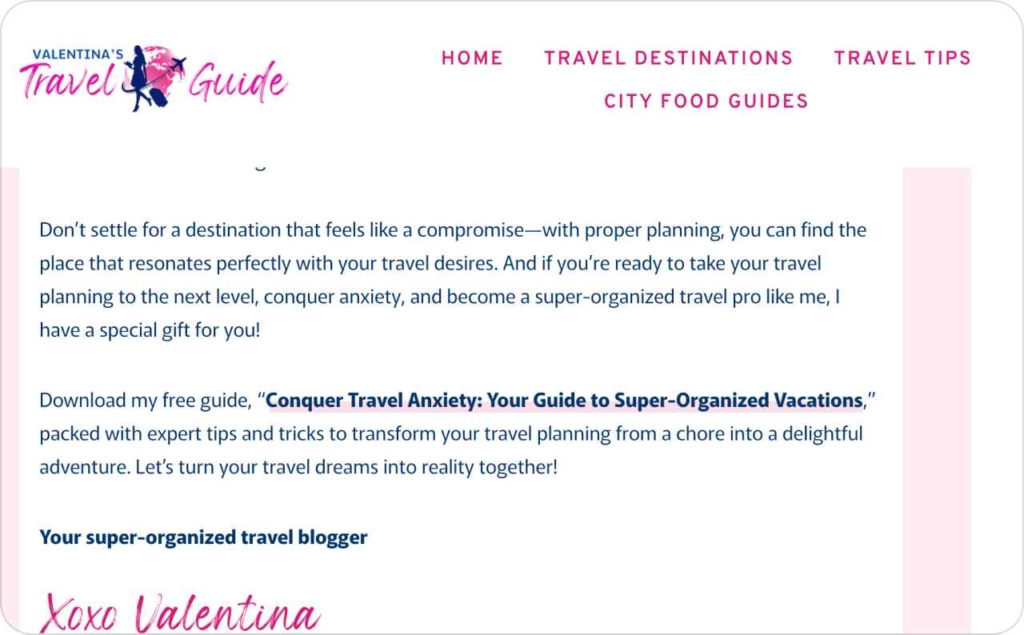
Photo source: Valentina’s Travel Guide
How to create interstitial ads with AI ad generator and without blowing budgets
AI helps you create variants faster. Gartner’s 2025 GenAI view shows near universal enterprise adoption by 2028, which supports rapid ad creative testing in your stack. If you’ve ever struggled with making ads that load fast, look polished, and don’t break your budget, an AI ad generator can change the game. With Zeely, you can handle AI ad creation in minutes — whether you want a static interstitial, a video takeover, or a playable demo. The goal is simple: create ads faster, easier, and more conversion-focused using one fast ad generator.
Step 1: Add your product URL or Shopify store
Paste your link, and the AI script tool automatically imports product data. This saves you hours of manual setup.
Step 2: Choose your ad format
Pick static ads, video ads, or even AI-powered avatars depending on whether you want speed, storytelling, or interactive appeal.
Step 3: Let AI generate the content
Zeely creates ad copy, visuals, and layouts in seconds. You instantly get a full-screen overlay ad you can test as an interstitial ads example for Android apps or websites.
Step 4: Edit quickly
Tweak colors, text, or music with built-in controls. Adjust until the ad feels like a seamless ad integration with your brand.
Step 5: Launch with one click
Push campaigns live directly through Meta integration. This cuts out complex setup and ensures faster time to market.
Step 6: Bulk generate for testing
Generate dozens of variants in minutes. This helps you run A/B tests, measure CTR vs eCPM comparison, and find the best-performing creative without overspending.
Next steps
You now have a clear playbook for using interstitials without hurting UX or SEO. Take three steps today.
- Pick one interstitial ads example Android and one website interstitial ads example that fit your funnel
- Wire in pre-cache ads, visible close, and frequency capping. Log impression, click, and dismiss so you can run a CTR vs eCPM comparison against banners
- Add one safety link to your doc for reviewers: Google Page Experience and AdMob interstitial guidelines. This keeps you compliant and speeds approvals
When results start coming in, scale the winners and retire the rest. If your CTR improves but retention drops, move the trigger to a cleaner natural transition point. Keep tests short, visual, and friendly to your users. That is how you grow revenue and protect rankings at the same time.
Also recommended

